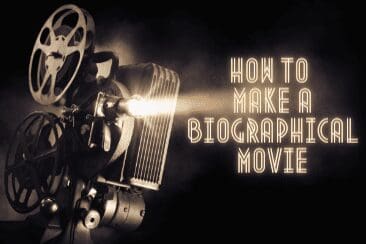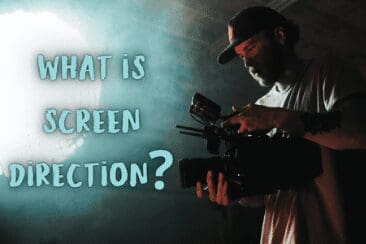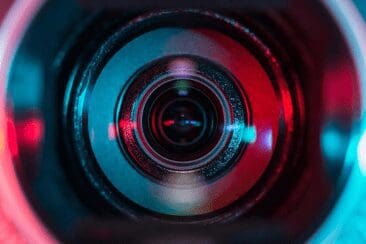Strap in – we’ve got quite the list of film terminology coming your way! Quite literally from A-Z, all the information you could need on movie terminology is curated right here. Both are for novice filmmakers, in addition to industry veterans who want to brush up on their knowledge.

From aperture to zoom shot, from backlighting to white balance, here is all the required film terminology on set, during development, and in post-production.
Why Do You Need To Know Film Terminology?

Filmmaking is hardly ever a solo venture. If it were, then it’d be fine to keep calling a fish-eye lens ‘the bendy-wendy one’. Or whatever other catchy names we tend to give things when we don’t know what the real name is.
Chances are, you are not the sole team member in the crew though. If you call a fish-eye lens ‘the bendy-wendy one’, and your camera operator calls it ‘the sphere-inator’, then bam! That’s a miscommunication you have to deal with.
Official film terminology exists to keep all members of the fim crew on the same page. It helps to streamline the entire filmmaking process. Also, once post-production is finished, it helps to create the best movie possible. Indeed, whether you’re a novice or a master, there is always something new to learn in the world of filmmaking.
Film Terminology Glossary
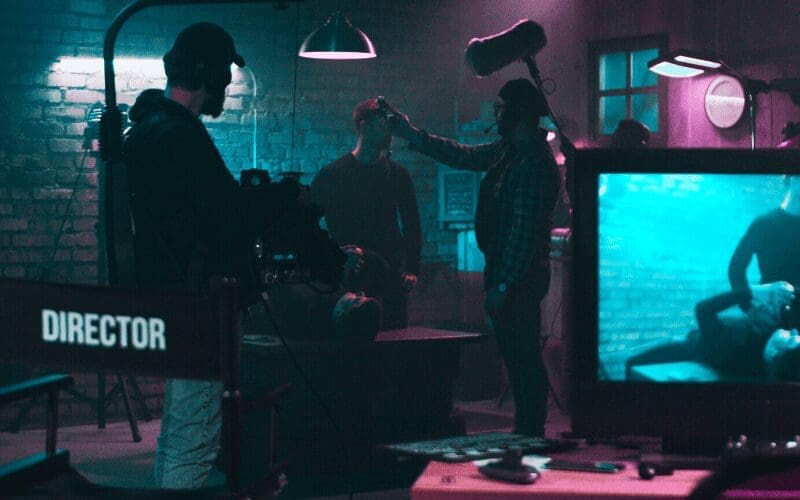
With that being said, let’s jump straight into our glossary of film production terminology and definitions!
Film Terminology – Aerial Shot
First up on our list of movie terminology is aerial shots. An aerial shot is a camera shot filmed from above, looking across or down at the subject. Usually, it’s captured using a crane, plane, helicopter, or drone. In addition, when an aerial shot opens a movie, it is called an ‘establishing shot’.
Aperture
An aperture is a part of the camera lens. It is the mechanism that controls the amount of light allowed to pass through the lens and reach the film. The wider the aperture, the more light is let in. The narrower the aperture, the less light is let in.
Backlighting
Backlighting is when the main source of light is behind the subject, facing toward the camera. Typically, this is utilized to create a silhouette.
Bridging Shot
In movie terminology, a bridging shot is utilized to indicate some kind of discontinuity in the film’s story; such as a jump in time or place. Examples include a shot of a map to indicate the characters journeying from one place to another. Or of leaves turning from green to orange to indicate a jump from summer to autumn.
Film Terminology – Close-Up, Close Shot
A close-up shot is taken very close to the subject. For example just the actor’s face, body part, or a singular object. This is done to emphasize focus on something very specific.
Cross-cutting
Cross-cutting is an editing method typically used to show two events happening simultaneously. But, in different settings. For example, two characters might be writing a letter to each other at the same time, both in their own homes. Cross-cutting will switch between the two characters to show that their letter-writing is happening simultaneously.
Depth Of Field
Any shot can be separated into planes. For example, the foreground, middle-ground, and background. Depth of field references the camera’s focus about these planes. Deep depth of field keeps all of the planes in focus. Whereas the shallow depth of field may only keep one plane in focus to draw your attention to it.
Film Terminology – Dolly Shot
A dolly shot is synonymous with some other movie terminology; ‘tracking shot’ or ‘follow shot’. The camera is mounted on a dolly that rolls across dolly tracks, enabling a smooth continuous shot across the distance. These days, hand-held steady cameras (‘Steadicam) are also often referred to as dolly shots.
Exposition
Exposition is the inclusion of important background information in a movie, usually used to set up the plot. Notoriously difficult to weave organically into the dialogue or editing of a film, exposition is often the bane of scriptwriters. But very effective when done well.
Fast-Cutting, Flash-cutting, Flash Editing
An editing technique primarily used to create action and fast-paced scenes, fast-cutting involves very brief, rapid cuts between different shots.
Fish-Eye Lens
A fish-eye lens is a type of camera lens that produces extreme wide-angle shots. The edges are very distorted and produce a curved visual, with the ability to wrap the shot around into a sphere.
Film Terminology – Gaffer
A vital member of the film crew, the gaffer is the head electrician. They are responsible for the design and execution of the set’s lighting.
Grip
Another vital crew member, the grips are responsible for all the moving pieces of equipment on a film set. For example. this could include dolly tracks, cranes, and lighting in coordination with the gaffer.
Handheld Shot
As it says on the tin, a handheld shot is captured by someone using a handheld camera. Often purposefully used to look shaky, handheld shots are effective when conveying chaos, and amateur video, and are particularly used in horror found-footage films like Cloverfield and The Blair Witch Project.
Insert Shot
In movie terminology, an insert shot is, quite literally, a short shot inserted into the middle of a larger shot. It’s typically used to draw the audience’s attention to a smaller detail for a brief moment, before returning to the main shot.
Film Terminology – Jump Cut
A jump cut is an abrupt, stylistically jarring, instant transitional cut that demonstrates a jump in time. Importantly, these can be difficult to implement effectively. This is because jump cuts go against the typical approach of telling a story without the audience becoming consciously aware of the movie’s editing.
Key Light
The key light is the main light on a subject. Usually placed at a roughly 45-degree angle and off to the side, the key light’s purpose is to illuminate the subject’s prominent features.
Film Terminology – Long Shot
A long shot is a shot of the subject taken from a very long distance away. A medium-long shot is a little closer, and an extreme-long shot is incredibly far away.
Magic Hour/Golden Hour
Magic/golden hour is one of the few entries in this basic glossary of movie terminology that’s also used in daily life outside of the set. It signifies the ~30 minutes before sunset and ~30 minutes after sunrise where the natural outdoor lighting conditions are perfect for romantic, calming, or magical scenes.
Film Terminology – Master Shot
The master shot is a long shot of an entire film scene. It is usually used as the basis for each scene, with closer shots and details edited in throughout its duration.
Mise-en-Scène
Translating to ‘putting-in-the-scene’, mise-en-scène refers to the overall visual composition of a shot. A kind of catch-all movie terminology, it can mean different things to different directors and cinematographers, but always comes back to the general composition and aesthetic of a scene.
Narration
Narration is done by a voice offscreen, either by a professional voice-over artist or one of the film’s acting cast. It usually provides extra information to the audience about the movie’s plot.
Overexposure
Overexposure refers to the camera letting too much light hit the lens. Resulting in a blinding effect, overexposure consequently makes it hard for the viewer to distinguish between objects and actors. Although can be used stylistically if done right.
Over-The-Shoulder Shot
Effective for conversation scenes, an over-the-shoulder shot focuses on one character while the camera looks over the shoulder of the other.
Film Terminology – PA
Standing for ‘Production Assistant’, this person’s role is… well, whatever the film needs. Indeed, their duties vary wildly from production to production.
Pan/Panning Shot
Short for ‘panorama’, a panning shot is a wide, rotational, continuous sweeping shot in one direction. Consequently, these are particularly used for showing off a massive landscape.
Pull-Back Shot
Typically done with some kind of dolly, the pull-back shot pulls away from the subject. Imagine the character’s been knocked out, and a close-up shot of their opening eyes pulls back to reveal their situation.
Push-In Shot
The opposite of a pull-back. Push-in shots are used to provide closer detail on the subject via a smooth camera movement.
Racking Focus
A filming technique that is done with the camera, racking focus moves the focal planes in a sequence. The result is an altering of the depth-of-field. This usually changes the focus from something in the background to the foreground, and vice versa.
Film Terminology – Reel
No longer used in modern cameras, the reel is used to refer to the spool that wound physical film. In modern movie terminology, reel more often refers to an actor or director’s highlight reel. This is a sort of video portfolio to get more work.
Rigger
Another member of the film crew. The rigger works with the gaffer and grips to rig up lighting and scaffolding.
Score
The film score is created specifically by a music composer for that film. Usually released as a full soundtrack album after the movie’s premiere, the score is a vital part of any film, and we don’t just say that because we’re musicians!
Shots, Scenes and Sequences
It might seem obvious, but it always helps to go over the basics! A shot is an individual piece of footage taken by one camera. Scenes are made up of a grouping of shots. Sequences are made up of a grouping of scenes.
Subject
The subject is a broad term used to identify the focal point of a shot. It can be anything that the director wishes to choose as the focus. This is usually one of the actors or an object.
Film Terminology – Tilt Shot
A camera shot that angles up or down, rotating around the horizontal axis. Tilt shots are usually used to suggest a character’s power or lack thereof.
Underexposure
Underexposure is when a shot is filmed with a less-than-standard amount of light being let into the lens. This results in a dimly-lit image with hard-to-distinguish features.
Vertigo Effect
The vertigo effect is a filming technique that involves the camera moving backward via dolly while simultaneously zooming in. The result is a dramatic visual with the subject remaining in the same place in the frame. This is while the background distorts around them.
White Balance
A camera setting that sets the ‘true color’ of white. As a result, all other colors captured by the camera are based on the white balance. This is useful because the color white may not appear properly ‘white’ under various lightings.
Film Terminology – Zoom Shot
Taken by a camera with a variable focal length, zoom shots enable the illusion of movement. Without moving the camera, the operator can zoom in for a closer shot of the subject. Or, zoom out for a longer/wider shot.
That Was Our Basic Glossary Of Film Terms
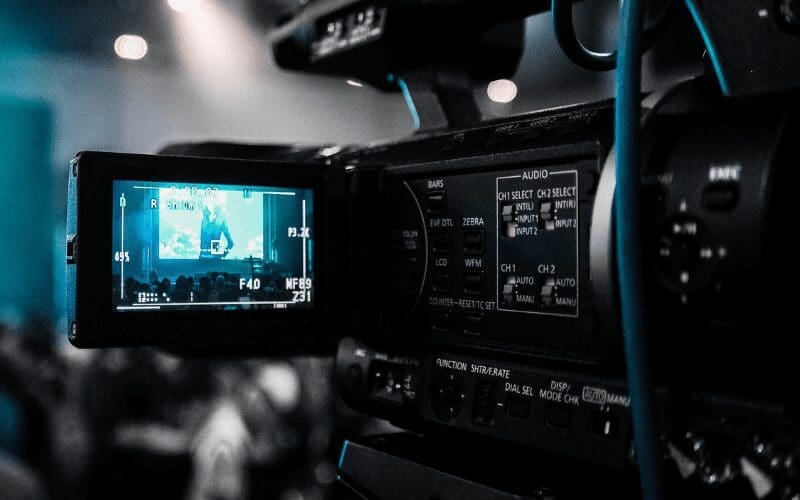
That’s quite the list – and it’s not exhaustive either! As we said earlier, when it comes to filmmaking, there is always more to learn. We’ve covered the basic film terminology here. In addition to some more advanced ones, which will be the basis of all your on-set communications.
Now that you’re armed with this knowledge, your next best step is to go and learn on the job. Filmmaking is a fantastic opportunity to let your creative mind soar. As well as meet fantastic people along the way who all share the same drive and passion as you. No doubt you’ll learn from them as much as they learn from you!
Lastly, if you’ve found our basic glossary of film terminology useful, why not check out some of our other film-related articles? Have a gander at How To Become a Filmmaker In 4 Easy Steps, Cinematography 101: What Is Cinematography?, How To Write A Script: The Beginner’s Guide To Scriptwriting, and How To Become A Screenwriter: A Beginner’s Guide.






